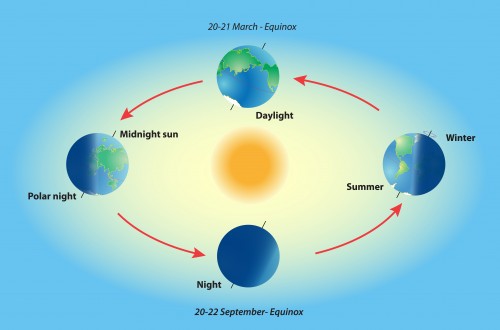The first day of autumn moves forward to September 22-23 * Why do those who observe the mitzvah of the holiday fast 25 hours and not 24? Why the moment day and night are equal does not really apply on the day of the equinox

Tomorrow, Wednesday, 23/9/15, Yom Kippur, is also the autumnal equinox or in other words the first day of autumn. In fact, at 11:20 Israel time, the sun will reach the plane crossing the equator, and the summer in the northern hemisphere will end, giving way to autumn.
As we know, the Earth's orbit around the Sun is inclined by 23.4 degrees compared to its orbit around its axis, when the Earth's axis is the imaginary line from pole to pole, and when you stretch the line from the North Pole up into the sky, it will point to Polaris - the North Star. And one of the results of This tendency is the changing of the seasons.
However, this movement around the axis is not uniform, there is a fluctuation around the axis known as 'precession' which means that at some point the axis turned so that the seasons were reversed - summer in the northern hemisphere occurred from December to February, and winter - from June to August. This thing happened for the last time about ten thousand years ago because Nakipa has a cycle of about 26 thousand years.
.
In the video we see the earth moving around the sun, the angle of the axis of rotation remains the same, and both halves of the globe - the northern and the southern - are directed towards the sun during the summer solstice and point out from the sun on the winter solstice. There are exactly two moments when both hemispheres are at the same angle relative to the sun - this is the vernal or autumnal equinox.
These moments do not always occur on the exact same day in each cycle, this is because of the way we calculate the minutes, days and years. This year the equinox falls on Wednesday, 08:20 GMT.
.
Why are day and night not really equal on the equinox?
There are indeed two days each year when the length of the day and the length of the night are close to 12 hours, but despite the name (the meaning of the Latin term for the equinox EQUINOX which means "the equinox"), these days do not fall on the equinox. Depending on the latitude where we are, in the northern or southern hemisphere, day and night are equal in length between 3 and 21 days before the vernal equinox and between three and 21 days after the autumnal equinox. The closer you are to the equator, the greater the difference between the actual equinox and the astronomical equinox.
If the movement of the sun is measured from the moment its center crosses the eastern horizon at the beginning of the day and when its center crosses the western horizon at the end of the day, it is indeed an equinox and it occurs on the true equinox, but in practice, the day-to-day definition of a 'day' is from the moment the edge of the sun rises above the horizon at sunrise until it disappears at the end of the wheel The sun is setting. Therefore, the length of the day is slightly greater than 12 hours on each "equinox".
Because of this addition, for example, those who observe the Yom Kippur fast, are forced to fast for about 25 hours (this figure contains a margin of safety). However, there is no connection between Yom Kippur and the equinox, even if only because it moves every year relative to the equinox or any other day in the Gregorian calendar, since the Hebrew year is based on the moon with corrections of adding the month of Adar B in leap years that limit this shift, while the civil calendar is based on the movement of the earth around the sun, therefore, any phenomenon related to the moon - the birth of the moon, or a full moon for example, will be on fixed days according to the Hebrew calendar but not according to the foreign calendar, and vice versa, any date related to the sun will be fixed (more or less) on the calendar the civilian, but it will move back and forth according to the Hebrew calendar.
Therefore, the connection between the autumnal equinox and the lunar eclipse expected in Sukkot (Monday morning) and the autumnal equinox is strictly coincidental.
The Autumnal Equinox no longer falls on September 21st and the Spring Equinox on March 21st. From the table in this link you can see that for viewers in Tel Aviv In every half of the current century - 2000-2049, the autumnal equinox swings between September 22 and 23.
There are several factors responsible for shifting this date, including changes in the Gregorian calendar (however, the Earth revolves around the sun once every 365 days and a quarter and one day needs to be added every four years, and therefore September 21st is on a multi-year average the day of the equinox and not always in practice), also The Earth's axis has an effect and the gravity of other planets also affects (albeit to a modest extent) the position of the Earth in its orbit.
Interestingly, spring shortens by one minute each year and winter by about half a minute per year. Summer gets the minute of spring and autumn gets the half minute lost to winter. Winter is the shortest astronomical season, as the pull continues to erode until it reaches a minimum length of 88.71 days around the year 3500.
More of the topic in Hayadan:
- Exploring the sun through ancient civilizations
- The first day of spring
- When is a throw red and when is it yellow?
